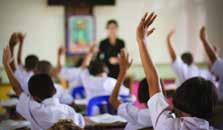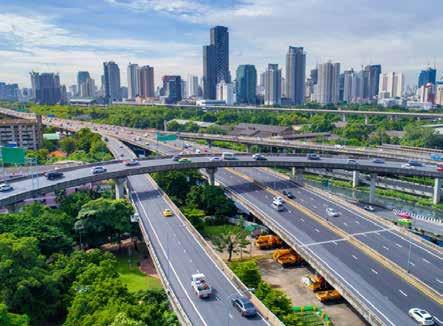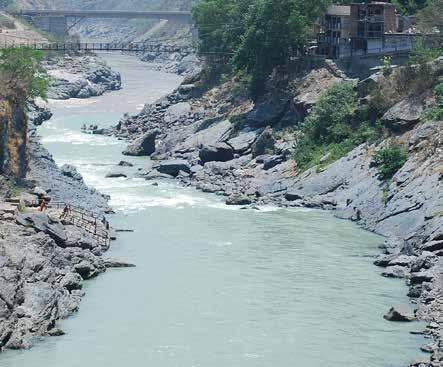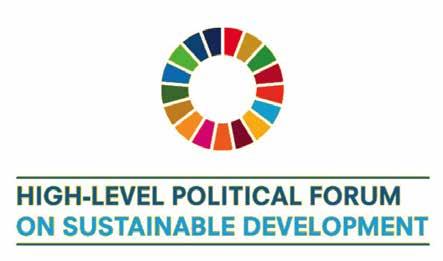
32 minute read
City Image
by Urban Update
Scientists plan to develop Earth’s digital twin
THE EUROPEAN HOUSE Agency (ESA) is working on a ‘digital twin’ of Earth with the hopes of better understanding our planet’s past, present, and future. The project, first declared in September, last year, can deploy AI, additionally as quantum computing, to create Earth’s digital doppelgänger in a virtual house. Therefore, scientists hope that this Digital Twin Earth can facilitate them forecast extreme, climate change-induced weather events and how they are impacting the Earth’s ecosystem.
Advertisement
SMC flags off 22 waste disposal vehicles
The Siliguri Municipal Corporation (SMC) introduced 22 new vehicles, which would be used by the conservancy department for prompt collection and disposal of waste across the Siliguri area. The initiative has been undertaken to meet the target of making Siliguri a ‘waste-free city’. Gautam Deb, Chairman of the board of administrations of SMC, informed about the incorporation of 22 new vehicles, which will be reserved for waste disposal purposes, of which, eight are covered vans and 14 e-rikshaws.
Puri first Indian city with safe drinking tap water
Naveen Patnaik, Chief Minister of Odisha, inaugurated the ‘Sujal’, or drinking-from-tap mission, on Monday, July 26. He informed that Odisha’s Puri has joined the league of big cities, including London, New York, and Singapore, to provide safe drinking water from tap for 24 hours, seven days a week. “Puri is the first city in the country to achieve 24X7 clean water directly from tap for drinking, cooking, and other household purposes. The water can be used directly as there is no need to filter it,” said Patnaik.
DTC’s entire fleet is ‘over-age’
NEW DELHI: 3760 Delhi Transport Corporation (DTC) buses operating in Delhi are beyond their age of six years, reported Hindustan Times (HT). Since the inception of DTC in 1971, this is the first time that the entire fleet of buses has been termed as ‘over age’.
HT informed that a majority of DTC buses have surpassed their technical limit for low-floor CNG buses. These buses have been operating for over eight years. According to Jawaharlal Nehru Urban Renewal Mission, a low-floor CNG bus can operate for a maximum of 12 years or till 7.5 lakh kilometers. The situation in Delhi is so alarming because the Government of the National Capital Territory of Delhi is in dire need of additional buses now, more than ever, to augment the ease of commuting for Delhiites.
Moreover, the maintenance cost of these old buses is also high. Vijay Bhaduri, Managing Director, DTC, informed HT that they are planning to add new buses to DTC’s fleet, keeping in mind the high cost of maintenance of these old buses. “Running over age buses can compromise on the safety of the people and State Transport Authority has now allowed using the buses up to 15 years, which will provide us a time window of 2-3 years to replace the entire fleet of buses,” he added.
Kailash Gahlot, Delhi Transport Minister, conceded that these buses are the lifeline of Delhi’s public transport. “So, we have planned to pump in 1300 new buses in the next few months,” Gahlot said. Currently, the city is in need of 11,000 buses and DTC is mandated to maintain a fleet of 5500 buses. However, the current strength of 3760 shows how low the actual number of buses in use are.
School reopening is a must to avoid ‘generational catastrophe’
NEW DELHI: The United Nations Children’s Fund (UNICEF) urged decision makers and governments across the world to plan and prioritize safe reopening of schools. It said that keeping schools shut due to the fear of COVID-19 might result in a ‘generational catastrophe’. A tweet by UNICEF’s official handle stated that it has been over 18 months since the COVID-19 outbreak started, and around 156 million children are still out of school. It added, “Getting children back into classrooms cannot wait.” The organisation had expressed concerns over nations allowing bars and restaurants to function, while keeping the schools shut.
UNICEF remarked in a statement that the losses that children and young people are incurring from not being in school may never be recouped. Issues like learning loss, mental distress, exposure to violence and abuse, missed school-based meals and vaccinations, and reduced development of social skills have arisen due to the shutting down of schools, the consequences of which will be faced by children in their academic achievement, social engagement, and physical and mental health. UNICEF stated that the children most affected by this are the youngest children for they are at key developmental stages, and are from low-resource settings, who do not have any access to remote learning tools. Therefore, school reopening cannot wait till cases go to zero.
Soumya Swaminathan, Chief Scientist, World Health Organisation, furthering the appeal of UNICEF, said that if teachers and adults working in schools are prioritized for vaccination and adequate preventative measures are in place, schools can safely reopen. Dr Randeep Guleria, Director of All India Institute of Medical Sciences (AIIMS), Delhi, had also commented that districts could reopen schools in a staggered manner.

BMC starts door-to-door collection of e-waste
Bhubhaneshwar Municipal Corporation (BMC) launched door-to-door collection of electronic waste in the city. The Corporation announced that it will run the e-waste collection drive on Saturday every week. For the first time in India, a drive has been started in a city to put a stop to littering of e-waste and mixing of e-waste with municipal solid waste. BMC is aiming to ensure segregation of waste at source with this drive. In the early phase, ten wards of the BMC will be eligible to avail this facility.
Karnataka first Indian state to reserve 1% seats for transgenders
Karnataka has become the first state in the country to reserve one per cent seats for the ‘transgender’ community in all offices of the Government of Karnataka. The state government has submitted a report to the High Court regarding this as the notification has already been issued after amending the Karnataka Civil Services (General Recruitment) Rule, 1977. The notification clearly states that one per cent reservation will be provided in general as well as reserved categories for the third gender. The notification also added that whenever an order is released to invite applications for government jobs, it should contain ‘other’ option along with that of male and female.
Lunar wobble and climate change to cause high tide flooding in US: Study
WASHINGTON DC: A new study conducted by NASA concluded that in the mid2030s, coastal areas in the United States of America will see a dramatic surge in high tide floods as the ongoing climate change on Earth will align with natural shifts in the moon’s orbit. The study was conducted by collecting data on astronomical causes of flooding. They found that the alignment of rising sea levels with the moon’s cycle will have a monumental impact on the number of high tide floods. Bill Nelson, the NASA administrator, explained that the lunar gravitational pull, along with the rising sea levels and climate change, has been furthering the coastal flooding along coastlines worldwide. In the report, NASA added that this is not a new development and neither is it dangerous. The National Oceanic and Atmospheric Administration reported over 600 high-tide related flood cases in the year 2019. In other words, many of the US’ coastal areas have already started witnessing the impact of climate change on tide levels. The new aspect found in this study is that the Moon’s gravitational pull, which causes Earth’s tides, will be even more impactful now that the rising sea levels will be furthered due to climate change.

Delhi transport department to show real-time bus information
DELHI: The Department of Transport, Government of National Capital Territory of Delhi (GNCTD), has joined hands with the tech giant Google to facilitate the launch of a system that will permit commuters across Delhi to access real–time information about buses, their arrival and departure times, and their routes.
The virtual launch was headed by Kailash Gahlot, Minister of Transport, GNCTD; Jasmine Shah, Vice Chairperson, Dialogue and Development Commission of Delhi; and officials from the transport department and Google.
Real-time bus schedules in the Capital will be available shortly, which will be accessible on Google Maps as well. The Delhi government is working with Google to incorporate the public transit system onto the Maps platform. “This will enable commuters to get an estimation of how long their trip is going to be, their arrival and departure times, and if their bus is delayed,” said Gahlot.
Dr Ravinder Singh Minhas, Deputy Chief General Manager, Delhi Transport Corporation, informed, “The project is deemed ‘commuter friendly’ and once it kicks off, static and dynamic real-time data of Delhi buses will be available for passengers. This project will not only enhance the public service experience for users, but will also enhance several other transit apps to tap into the open data portal of the transport department for more innovative ideas to flourish.” In 2018, the Delhi government had promulgated Open Transit Data with technical aid from Indraprastha Institute of Information Technology, Delhi to provide real-time data. “We are glad to work with Delhi’s transport department in launching real-time transit information for the Delhi Integrated Multi-Modal Transit System agency on Google Maps,” Ramesh Nagarajan, Global Head, Network Cloud, Google, said.
CHANDIGARH: The Government of Haryana has proposed a rehabilitation scheme for Khori slum dwellers of Faridabad under which, EWS flats equipped with electricity, water and toilet facilities will be provided in the nearby Dabua Colony and Bapu Nagar area. Around 50,000 migrants settled in Khori area of the Aravali forest in Faridabad district are on the verge of becoming homeless as the Supreme Court has instructed the land to be cleared of encroachments. According to the conditions laid down for the scheme, people who feature in the electoral list of the National Capital Region of Delhi will be excluded. Three documents have been decided, which will set the criteria for the residents of Lakkarpur Khori to be included in the rehabilitation scheme. “In this, the income of the applicant’s family should not exceed Rs 3,00,000 annually, and the name of the head of the family should be registered in the voter list of the Badkhal assembly constituency of Haryana as on January 1, 2021,” Garima Mittal, Commissioner, Faridabad Municipal Corporation (FMC), stated.
“The head of the family should also have a ‘Parivar Pehachan Patra’ (family ID card) issued by the state of Haryana before January 1, 2021,” she said.
The FMC commissioner also informed that the people who will fall under the prerequisite criteria will be allotted Economically Weaker Section category flats, fully equipped with electricity, water supply and toilets. An amount of Rs 2000 per month would be extended to the person concerned, till the time houses are under construction. This will supplement their rental expenses. The money would be transferred to the people concerned in the form of instalments.

Behavioural intervention can help reduce water consumption: Study
BANGALORE: The Indian Institute of Management, Bangalore (IIM-B) conducted a study that concluded that behavioural interventions can influence household water conservation with a long term impact. The research was conducted by field experimentation and implementing a habit change in a set area. Kanchan Mukherjee, the lead author of the study, explained the basis of the experiment and how habits are intertwined in human life.
“When people act in a particular way repeatedly, such as taking a shower every day, they do it in an automatic mode without much conscious thought. That is why attempts to persuade people to conserve water by appealing to their better senses has had limited success. People may get influenced by these messages temporarily, but the force of habit eventually takes over and behaviourial change is short-lived,” said Mukherjee. The study established a framework which induced a habit change in one’s conscious awareness. These actions, directed by unconscious thought, lack self-awareness and may have an unfavourable impact. The intervention, which lasted for five weeks, reduced household water consumption by about 25 per cent. “More importantly, the effect lasted for the entire observation period of two years after the intervention was stopped, establishing the potential of using behavioural methods to achieve a significant long-term reduction in water consumption,” read a statement released by IIM-B.
Delhi civic bodies prepare for third COVID wave
East Delhi Municipal Corporation has devised a plan for strengthening medical infrastructure and spread awareness on COVIDappropriate behaviour and vaccination. Officials from all three municipal corporations of Delhi said both the waves had exhausted the medical system to its limits. Therefore, efforts are being made to ensure the situation does not repeat. “We are focusing on the vaccination drive and around 5.75 lakh people have been inoculated at our centers. If the situation worsens, we will be prepared,” said Mukesh Suryan, Mayor, South Delhi Municipal Corporation.
Odisha ULBs to spend 25% on slums
The Government of Odisha directed all urban local bodies of the state to spend 25 per cent of their budgetary allocation on the development of slum areas. Sangramjit Nayak, Director (Municipal Administration), Government of Odisha, wrote letters to the authorities of all 114 ULBs in the state. In the letter, it has been said that the government has made an amendment in the Odisha Municipal Act 1950, and the Odisha Municipal Corporation Act 2003. These amendments make it mandatory for all ULBs to spend a sum equivalent to 25 per cent of the amount under capital expenditure relating to development work for providing basic service and infrastructure to slums.
COVID-19 lockdown increased pace of Telangana’s urban development
HYDERABAD: KT Rama Rao, Minister for Municipal Administration & Urban Development, Industries & Commerce, and Information Technology, Government of Telangana, released the Telangana Municipal Administration and Urban Development (MAUD) annual report for the year 2020-2021 on July 9. This was the fourth such report released by Telangana. He said that because nearly half of the state’s population resides in urban areas, the development of urban local bodies is a top priority for the state government.
The report stated that the government and authorities made use of the lockdown period during the COVID-19 pandemic, and took up major urban infrastructure development works like laying greenfield link roads, flyovers, rail under and over bridges, and recarpeting of existing roads. During the lockdown period, the development works on roads were taken up for 12-16 hours every day because the roads were free of traffic. It was in stark contrast to working for only three-four hours during normal days.
Rao praised the services of frontline workers of MAUD department during the pandemic, where they also ensured daily sanitation, water supply, and other essential services. Works which would have normally taken at least nine to twelve months for completion, was completed in a record time of only twofour months.
The Government of Telangana has decided to complete a long overdue project of construction of 15 new bridges across River Musi in the city. These bridges are to help millions of people save time and ease their travel, and additionally open up new areas for planned development. Strategic Nala Development Plan (SNDP) has also been initiated to plan and execute proper drainage, surplus water flows in Hyderabad Urban Agglomerate during the rainy season.
Arvind Kumar, Principal Secretary, MAUD, said that the state is planning an Urban Centre of Excellence, which will be the hub of urban research, startups, training and conferences, and will work as a center addressing urban issues meaningfully. The state is also planning a greenfield township ‘Neopolis’ at Kokapet. Planned infrastructure growth for the same is already underway and it will become a new hub, thereby playing a crucial role in Hyderabad’s growth. In a bid to make urban local bodies (ULBs) financially sustainable, around 20 ULBs in the state got the ratings done in the past year and nine of them are in the process of accessing market borrowings based on their ratings.
The report described implementation of TS Building Permission Approval and Self-Certification System (TSbPASS), a self-certification based instant approval process for building permission, as a major highlight of the year. Over 28,000 instant approvals have been issued since its introduction in Telangana. The system launched to ensure transparency, strict timelines, and zero tolerance to corruption, has ensured minimizing citizens’ interface with officials, which will go a long way in ensuring convenience for citizens. A first-of-its-kind Trauma Care facility in the country was also introduced on Outer Ring Road (ORR) by the Hyderabad Growth Corridor Limited (HGCL) at 10 interchanges, thereby rendering exceptional services for any emergency/accidents taking place on the ORR. The report also mentioned construction of first cablestayed bridge lighting in India at Durgam Cheruvu with architectural illumination, deck lighting, and rock lighting, with a project cost of Rs 184 crore. LED Street lighting on ORR was also commenced for balance stretch of length 136 km, which is to facilitate improving the safety of road users on ORR and control any anti-social and illegal activities.

Cities are filling tech gaps but governance gap sill prevalent: Report
GENEVA: A report titled ‘Governing Smart Cities’ was released by the World Economic Forum on July 13 which seeks to help city leaders identify gaps, protect long-term interests, and keep up with the pace of technology. It tries to provide a benchmark for ethical and responsible use of smart city technologies by looking into the inner workings of 36 pioneer cities. The report established that cities of all sizes, geographies, and levels of development across the world have serious governance gaps, including failure to designate a person accountable for cyber-security or to assess privacy risks when procuring new technology systems. City leaders can close these gaps and protect long-term by acting immediately. The report follows the call to action from G20 ministers in 2019 that resulted in the formation of G20 Global Smart Cities Alliance to act as a platform to help cities strengthen their knowledge, expertise, and governance of smart city technologies. Over 2,00,000 cities, local governments, leading companies, start-ups, research institutions, and civil society communities are represented by the Alliance and its partners.
According to the report, in spite of an unprecedented increase in global cybersecurity attacks, most cities have not yet designated a specific government official as an ensuing accountable person for cyber-security. Even though, majority of cities were found to recognize the importance of protecting the privacy of their citizens, only 17 per cent of the cities surveyed are in the practice of carrying out privacy impact assessments before deploying new technologies. In a bid to understand and assess the implementation of a set of five essential policies identified by the G20 Alliance last year, government officials and policy experts were interviewed between January 2021 and March 2021.
NEW DELHI: A multi-agency United Nations report published on July 12 established that world hunger and malnutrition levels have worsened dramatically in the last year. The report mentioned that the increase is likely due to the COVID-19 pandemic.
The report published by the United Nations and prepared by agencies including the Food and Agriculture Organisation, and the World Health Organisation, said that the number of undernourished people across the world has risen to about 768 million, which is equal to 10 per cent of the world’s total population. The foreword of the report said that the pandemic continues to expose weaknesses in the world’s food systems. No region in the world has been spared the increased hunger and malnutrition, which threatens the lives and livelihoods of people globally.
Pandemic took ‘zero hunger’ farther from reach: UN report
According to the report, more than half of all the undernourished people live in Asia. Additionally, Africa witnessed the biggest jump in cases of malnutrition in the last year, at 21 per cent of its population. More than a third of Africa’s population is estimated to be undernourished as per the report. It stressed that children remain the ones who pay the highest price among the victims as more than 149 million children, who are aged less than five, are estimated to be afflicted with stunted growth. This report is the first comprehensive assessment done on food security and nutrition since the COVID-19 pandemic emerged in December 2019. It mentioned that hunger was spreading around the world even before the pandemic, with other major causes of food insecurity being conflict, economic recessions, and climate extremes.
Kerala to strengthen PPP mode in healthcare sector
Veena George, Minister of Health, Government of Kerala, said that the state will adopt the Public-Private Partnership (PPP) model in the healthcare sector. Addressing a virtual meeting organised by Federation of Indian Chambers of Commerce and Industry (FICCI)’s Kerala council, George said that the state has set an example in tackling the COVID-19 pandemic. George added that although complex diseases after COVID-19 have been reported in the state, it has set an example in COVID-19 resistance. She added that Kerala has invested and developed the health infrastructure and the PPP model will strengthen it further.
38 smart parking lots to be developed in Patna
Patna Municipal Corporation (PMC) will be developing smart parking lots in 38 locations on pilot basis due to the increased number of vehicles on city roads causing heavy traffic. The official source said that a Haryana-based private firm has been assigned the task and the authorities are expecting to finish the work by August-end this year. The official said that the project has been prepared on publicprivate partnership (PPP) basis to address the conventional parking problems in Patna. The smart parking lots will contain LED direction signage for better guidance and other facilities like portable cabin, drinking water, toilets, etc.

NMCG launches initiative to make Ganges Basin cities water sensitive
NEW DELHI: National Mission for Clean Ganga (NMCG), in association with Centre for Science and Environment (CSE), launched a new capacity building initiative on ‘Making water sensitive cities in Ganga basin’. It aims to improve river health/ flows by focusing on water sensitive urban design and planning, urban water efficiency and conservation, decentralized wastewater treatment and local reuse, urban groundwater management and urban waterbodies / lake management.
Shri Rajiv Ranjan Mishra, Director General, NMCG, reiterated the need for respecting traditions and proposed that focus should be on the basics of water cycle in urban areas. He emphasized on the need to protect, conserve, and restore the ecosystem along with pollution abatement. He also gave insights on Jal Shakti Ministry’s ‘Catch the Rain’, initiative which focuses on rain water harvesting. He said that there is an urgent need for public spaces in urban spaces - meaning river fronts which connect communities with water bodies in cities.
Mishra emphasized on creating a framework for integrating Urban Built Form by including landscape and urban water cycle. He said that since a larger share of responsibility for the deteriorated state of rivers lies on cities, therefore, they need to play a vital role in the rejuvenation efforts as well. For the first time, there was a paradigm shift in planning for River Cities. He mentioned a unique platform for river cities to collaborate and collectively achieve river rejuvenation through sustainable development and capacity building - the ‘River Cities Alliance’.
Shri Suresh Kumar Rohilla, Senior Director, CSE, said that the aim of the initiative is capacity building and action research for promoting sustainable urban water management, which may cause improved river health in Ganga basin cities. He further explained how the program will engage all stakeholders, including SPMGs (State Program Management Group, Namami Gange), municipal corporations, technical & research constants, international organizations, and local grass-root communities.
Sunita Narain, Director General, CSE, pointed to the impact of climate change on rivers and hydrology. She shared data highlighting how the intensity of rain has increased over the years but the number of rainy days has reduced, making water management one of the most crucial subjects. She stressed on the need for returning to roots and bringing back the traditional knowledge of rain water harvesting by giving examples of Ahar Pyne system of Bihar, wells in forts of Rajasthan, and of South India’s Cascade tanks, etc.
This initiative is part of a series of ongoing efforts by NMCG aimed at ensuring convergence of the Namami Gange Mission with national flagship urban missions like AMRUT, Smart Cities, Swachh Bharat Mission, HRIDAY, NULM, alongside other missions like Atal Bhujal Yojana, Jal Jeevan Mission, Jal Shakti Abhiyan at state /city level across Ganga basin states. This initiative would include more than 40 training programs supported with development of learning materials/ practitioner’s guides and spread over a period of three years. The programmes will comprise of residential trainings, online trainings, field visits, and webinars etc. The initial phase of the project will be implemented in 3-4 pilot cities within the Ganga basin. This is a first of its kind capacity building program. More than 840 people have participated in this event from nearly 240 cities across 33 countries.
In order to minimize hydrological impacts of urban development on environment, Water Sensitive Urban Design and Planning is an emerging urban development paradigm which includes the method of planning and designing urban areas for optimum utilization of water, reduce the harm caused to our rivers and creeks and focuses on complete management of entire water systems (drinking water, storm water run-off, waterway health, sewerage treatment and re-cycling).
Maintaining population growth is SDG inclusive, claims Yogi Adityanath
LUCKNOW: At the launch of the Draft Regulation Policy 2021-30 on July 11, Yogi Adityanath, Chief Minister of Uttar Pradesh, said that high and ever increasing population can be a deterrent to the development goals. The launch of the policy, entailing various aspects of a person from birth to old age, was held on the occasion of World Population Day, and the CM said that the new policy takes every community into account.
CM Adityanath added that high population is connected with poverty and the issue requires awareness among the people. Yogi added that this issue is also related to sustainable development goals set by the United Nations. He informed that the state of Uttar Pradesh, which is currently the most populous state in India, will work to deal with the issue. The policy introduced has set the goal of reducing the state’s reproductive rate to 2.1 by 2026 and to 1.9 by 2030. In line with the CM’s aim of controlling the state’s population growth, the first draft of the Population Control Bill was released by the Uttar Pradesh State Law Commission, which includes provisions to exclude people with more than two children from the benefits of government schemes and perks. Justice AN Mittal, Chairman, UP State Law Commission, informed that this bill proposes to disentitle the violators of the twochild policy from contesting local body elections and from applying for government jobs in the state. The bill also has a provision to limit ration card units to four. Moreover, the new Population Control Bill proposes to provide rebates on water and electricity bills, house tax, home loans to people who are not in government service but follow the two-child policy.
WASHINGTON: A group of leading climate scientists found in an analysis that the record-breaking heat wave witnessed in western United States of America (USA) and Canada at the end of June would be ‘virtually impossible’ without human induced climate change. The group of scientists named as the World Weather Attribution Group said that due to global warming caused by Green House Gas emissions, the heat waves were 150 times more likely to happen. The heat waves caused rise in temperature in Pacific Northwest areas of the two countries by several degrees and Lytton in Canada saw record temperature of 49.6 degree Celsius and was completely destroyed by wildfires. Friederike Otto, Climatologist, University of Oxford, said that there is no doubt that climate change has played a key role in the occurrence. The scientists studied historical observations and computer simulations to compare the climate with present situation, which is a result of a 1.2-degree Celsius rise in temperature due to global warming since the late 1800s.
Predicting future occurrences, the study said that if the planet warms by 2 degrees Celsius, which could happen as early as in the 2040s at the current rate, heat waves like this can occur every five to ten years. The researchers suggested two broad explanations as to how climate change made it more likely. First explanation says that pre-existing drought deprived the area of evaporative cooling and made a slow-moving high pressure system in the atmosphere, which was supercharged by climate change. The second theory suggests that climate change has crossed the threshold where even a small amount of overall global warming is inducing a sharp rise in temperatures.
Climate change made North American heat wave likely: Study
Seoul organises fashion show to promote ecofriendly clothing
The Metropolitan Government of Seoul, in partnership with the Green Seoul Citizens Committee, hosted a fashion show on July 9 to underscore the importance of climate variability at Dongdaemun Design Plaza in central Seoul. The show with slogan ‘Dealing with climate change with citizens’ was held behind closed doors without an audience. Lee Dong-ryul, a senior official overseeing the city’s environmental policy, commented that this event was organised in view of the government’s plans to attain net zero emissions of carbon by 2050.
Karnataka government will construct 9 lakh houses in 2 years
The Government of Karnataka decided on July 8 to construct nine lakh houses within two years under various housing schemes of the state. This decision was taken during a review meeting chaired by Chief Minister B S Yediyurappa on housing schemes of the state. A release from the Chief Minister’s Office said that under this, five lakh houses will be constructed under state housing schemes and four lakh will be constructed under central housing schemes. It added that a subsidy of Rs 1.75 lakh is to be provided to beneficiaries from scheduled castes and a Rs 1.2 lakh subsidy will be provided to others for construction of houses.
Countries discuss need to act on Agenda 2030
The High-Level Political Forum (HLPF) is a platform established by the United Nations to discuss sustainability goals. The HLPF meeting, held from July 6 to July 15, reviewed the 2030 Agenda for Sustainable Development and its 17 Sustainable Development Goals
NEW DELHI: The High-Level Political Forum 2021 was a three-day ministerial event conducted under the auspices of the Economic and Social Council. In the HLPF meeting, different ways to ensure a sustainable and resilient recovery from COVID-19 that puts us on track to realize the 2030 Agenda were discussed. This year’s theme was “Sustainable and resilient recovery from the COVID-19 pandemic that promotes the economic, social and environmental dimensions of sustainable development: Building an inclusive and effective path for the achievement of the 2030 Agenda in the context of the Decade Of Action and delivery for sustainable development”. The 2030 Agenda is an action plan for the people, the planet, and its prosperity. The Agenda seeks to build on the Millennium Development Goals and achieve the goals that were not done by it. Not only does the 2030 Agenda include sustainable development goals, but it wishes to balance its three dimensions: economic, social, and environmental.
The Sustainable Development Goals (SDGs), or the Global Goals, formulated by the United Nations, are a collection of 17 interlinked goals designed to lead us towards a sustainable future. The HLPF discussed the 17 SDGs that are based on poverty, zero hunger, good health and wellbeing, economic growth, reduction of inequalities, responsible consumption and production, climate action, peace, and strong institutions, and on partnerships in depth. The Formulators of Agenda 2030 and the SDGs did not take into account the coronavirusinduced pandemic and how it might hamper the timeline. The participants of the meet discussed the response to the pandemic and calculated its impact. They explored policies and international cooperation that is necessary to control the pandemic and to put the globe back on track to achieve the SDGs by 2030. In order to conduct a follow-up, the 2030 Agenda encourages members to conduct regular reviews of the progress done by countries. Agenda’s 84th paragraph declared that the national reviews by the HLPF are to be state-led, voluntary, should include both developed and developing countries, and should provide a platform for stakeholders and partners.
In the concluding remarks by Oh Joon, President, Economic and Social Council (ECOSOC), deep concern over the impact of the COVID-19 pandemic on the SDGs and most notably poverty, equality, and environmental crisis, was expressed. He emphasized that global solidarity is the need of the hour. Joon said that the responsibility of providing financial support to developing countries should be shared equally. He highlighted that the ministers and the leaders were aware of what is needed to be done to recover faster. The stimulus packages introduced by the countries should support investments in sustainable infrastructure, strengthening social protection systems, ensuring universal health coverage and the SDGs. Talking about the ministerial declaration, he said that it expresses the commitment to the 2030 Agenda and the realization of the vision of a sustainable future.
The ministerial declaration recognized the crisis caused by the COVID-19 pandemic and how it exacerbated the globe’s vulnerabilities by highlighting the inequalities within the countries. The pandemic also highlighted the systematic weakness that threatens to slow down the progress made towards realizing the Sustainable Development Goals. The Ministerial declaration emphasized the need for a renewed commitment to the policies of sustainable development. The ministers declared that they will be open to conduct inclusive and transparent discussions on the proposed measures of “total official support for sustainable development”. They also reaffirmed the commitments towards creating an environment at all levels that would work towards achieving relevant SDGs. The declaration also read that the ministers are committed to significantly increase access to information and communications technology. They will strive to provide universal and affordable access to internet in at least the developing countries.

Indian vaccine rollout could have been better, says majority
NEW DELHI: Team Urban Update conducted a survey on ‘Issues in the Great Indian Vaccine Rollout’ to better understand the vaccination campaign run by the Government of India. India officially launched its vaccination drive on January 16 this year, with Covishield and Covaxin. Over 74 per cent of people agreed that the vaccination drive could have been better, while 20 per cent were unsure and the remaining five per cent were satisfied with the route chosen by the authorities. According to data collected by the Ministry of Health and Family Welfare, over 12.1 crore people had been fully vaccinated till August 16. When asked if people thought the vaccine being administered in India has reduced the COVID-19 caseload, 78 per cent said yes, 16 per cent said maybe, and the rest said no.
Initially, the urgent rollout of the vaccination drive led many individuals to wonder if the vaccine was safe. What started off as a rumour by a boomer became a reality as it translated into low numbers of Indians who were willing to get the vaccinated. It was then that the government started campaigning for the vaccine which helped over 68 per cent of individuals get over vacancy hesitancy. Of the 35.8 per cent people who have been vaccinated, over 24.5 per cent still have to receive their second dose.
One of the major reasons for vaccine hesitancy is uninformed opinions shared online which were perceived as facts. Over 54 per cent of people were satisfied with the COVID-19 related information received through media, while 34 per cent were not and 12 per cent were unsure. Media, especially social media, brings the mic to the micro-level for an incomprehensibly large audience. Hence it plays a key role in addressing issues and drawing the government’s attention to the concerns of the
24.70%
6.80%
68.50%
Do you think the COVID-19 vaccine awareness campaigns helped people overcome vaccine hesitancy?
Do you think the COVID-19 vaccines being administered in India have been effective in reducing the caseload?
Do you think the vaccine rollout process could have been better?
16.40%
5.50%
78.10%
20%
6%
74%
Yes No Maybe
citizens. It is especially vital in a public health emergency as it can inform the public about non-pharmaceutical interventions and broadcast information about COVID appropriate behaviour.
The prices of vaccines available in India (Covaxin, Covishield, Sputnik, and Moderna) have been decided by their respective manufacturers. Bharat Biotech has said that its Covaxin will cost `600 for state governments and `1200 for private hospitals. Serum Institute of India sells its Covishield, which has been developed by OxfordAstraZeneca, at `400 to states and at `600 for private hospitals. The Russian Sputnik is available for `995 in India. Over 47 per cent of people believe that the vaccines have been priced appropriately. On the other hand, 53 per cent were dissatisfied with it. Experts believe that putting a price on vaccines in India as high as the per day wage of most of the population would put people off and push them away from getting the vaccine. However, it must also be noted that most people are availing free vaccines from government centres.
Currently, the vaccine is not available for children. The pandemic has taken away almost two academic years for students across the world with nearzero classroom learning and only online teaching. This has not only hampered their skill development but experts fear that it has plucked children out of their social circles. The reopening of schools largely relies on their vaccination numbers. About 80 per cent people agreed that they are ready to get their child vaccinated once the government approves it, while the rest were unsure. Mansukh Mandaviya, Minister of Health and Family Welfare, Government of India, said in July 2021 that the vaccine would be open for children in August. The European Union approved the use of the PfizerBioNTech mRNA vaccine on July 23 this year for adolescents aged 12-15.










